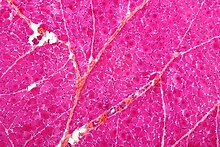Denervation

Denervation is any loss of
Causes
The loss of nerve supply can be caused by injury, disorders, or result from a surgical procedure.
Injuries
Denervation may be the result of nerve injury. The three main types of nerve injury are neurapraxia, axonotmesis and neurotmesis. These three types distinguish between the severity of the nerve damage and the potential for recovery after the damage. After an injury in which some nerves are damaged, the brain has shown capabilities in rewiring or rearranging neuronal circuitry. This plasticity allows for the brain to compensate for the loss in neuronal communication resulting from injury.[7]
Disorders
Denervation processes have a strong association with the symptoms seen in
Much like post-polio syndrome,
Surgical procedures
In addition to
Other prevalent surgical procedures involve intentionally reducing nerve supply to treat a variety of disorders. In a
Physiological differences
In regard to skeletal muscle denervation there are two distinct diagnoses: entrapment and compressive
Following denervation, muscular atrophy and degeneration occurs within affected skeletal muscle tissue. Within the skeletal tissue is observable progressive loss of weight of denervated muscles as well as reduction in muscle fiber size and quantity. These muscles exhibit a slowing of contraction speed, a reduction of developed tension, and twitch force.[8]
Denervation affects the muscle activation process that is brought on by the development and propagation of an action potential and the ensuing release of calcium. It is found that there is an increase with calcium reuptake because of changes within sarcoplasmic reticulum morphology and structure. As a result, there is a decrease in amplitude and velocity of impulse conduction with an increase in muscle spike duration.[17]
In clinical and experimental studies there is an observed increase in muscle excitability in electrical currents involving chemical actions, while there is a decrease in excitability to current associated with electrical induction in denervated muscles. Changes in the resting membrane potential involving denervated muscles presents mild depolarization when a muscle contraction stimulus is present. While there is no immediate change involving resting and action potential, there is an increase with membrane resistance. After prolonged denervation, it is revealed that resting membrane potential over time is reduced while action potentials progressively decreased and become slower. Acetylcholine is a neurotransmitter that becomes supersensitive in the presence of denervated muscle. Upon injection of acetylcholine, a slower contractile response, which is drastically under action potential threshold, is elicited.[17]
Reinnervation possibilities
Denervated muscles have shown the ability to survive after periods of denervation or in the case of a damaged nerve. The size of the nerve and its ability to function can be maintained if it is electrically stimulated soon after denervation, in clinical experiments. home-based functional electrical stimulation has been shown to rescue muscles which have experienced severe atrophy as a result of denervation.[18] This process involves electrically stimulating the nerves innervating the affected part of the body, using electrodes placed on the skin.[citation needed]
For muscles that cannot be rescued via home-based functional electrical stimulation, an Italian study suggests that, at some point in the future, the following techniques may be applicable: they must first have induction and separation of autologous
References
- PMID 12531915.
- S2CID 222209385.
- PMID 3315237.
- S2CID 147705420.
- S2CID 3301605.
- PMID 22048676.
- ISSN 1098-2779.
- ^ S2CID 44657605.
- ^ "Millennium Web Catalog". 0-hmg.oxfordjournals.org.libus.csd.mu.edu. Retrieved 2016-04-01.[dead link]
- S2CID 22838976.
- PMID 25431461.
- PMID 26017654.
- ^ https://www.ncbi.nlm.nih.gov/books/NBK559059/
- PMID 24139666.
- S2CID 44963601.
- ^ PMID 16843749.
- ^ S2CID 1993670.
- ^ PMID 26913148.
